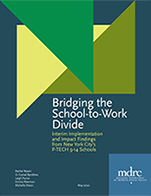Bridging the School-to-Work Divide
Interim Implementation and Impact Findings from New York City’s P-TECH 9-14 Schools

 The New York City P-TECH Grades 9-14 schools represent an education model that ties together the secondary, higher education, and workforce systems as a way to improve outcomes in both domains. The distinguishing feature of the P-TECH 9-14 model, as it is referred to in this report, is a partnership between a high school, a local community college, and one or more employer partners that focuses on preparing students for both college and careers — not one or the other — within a six-year timeframe.
The New York City P-TECH Grades 9-14 schools represent an education model that ties together the secondary, higher education, and workforce systems as a way to improve outcomes in both domains. The distinguishing feature of the P-TECH 9-14 model, as it is referred to in this report, is a partnership between a high school, a local community college, and one or more employer partners that focuses on preparing students for both college and careers — not one or the other — within a six-year timeframe.
Education and workforce development are traditionally seen as separate spheres of influence with multiple transition points that students have been left to navigate largely on their own (for example, high school to postsecondary, and postsecondary to the workforce). P-TECH 9-14 is designed to seamlessly assist student navigation of those points — supporting student success and mitigating the potential for students to fall through the cracks. P-TECH 9-14 schools collaborate with local colleges to provide students with an opportunity to earn a high school diploma (within four years) followed by a cost-free, industry-recognized associate’s degree. During the six-year program, employer partners support P-TECH 9-14 schools by providing students with work-based learning experiences such as internships, mentoring, and job shadowing. By design, the P-TECH 9-14 model offers students the opportunity to participate in focused and accelerated high school pathways, early college, and career-focused activities.
This study offers initial impact and implementation findings from the first rigorous evaluation of the model, evaluating the first seven P-TECH 9-14 schools that opened in New York City. The study leverages the random lottery process created by the New York City High School Admissions System to identify impacts. The majority of the students in the sample who participated in the admissions lotteries were academically below proficiency in both math and English language arts (ELA) prior to entering high school.
Key Findings
- Students’ high school coursework and New York State Regents exams are accelerated, and all schools focus on career and technical education (CTE) programs — classes that teach students specific workplace skills aligned with the labor market and “soft skills” such as good work habits and interpersonal skills.
- College coursework begins largely in tenth grade and the pacing and progress of course taking varies by student. The degree pathways are designed to complement the high school CTE coursework and lead to credentials toward specific careers.
- The specific work-based opportunities available, such as workplace visits, job shadowing, and internships, and levels of participation differed across schools.
- P-TECH 9-14 students earned more total credits than students in other schools, with results driven by credit accumulation in CTE and other nonacademic subjects. These additional credits did not appear to come at the expense of earning academic credits.
- At the end of two years of high school, 42 percent of P-TECH 9-14 students had passed the ELA Regents exam with a score qualifying them for enrollment in City University of New York (CUNY) courses, compared with 25 percent of comparison group students. By the end of three years, the gap was smaller but still favored P-TECH 9-14 students.
- These pass rates indicate that more P-TECH 9-14 students were eligible to dual enroll in CUNY coursework in earlier years than their comparison group counterparts.







